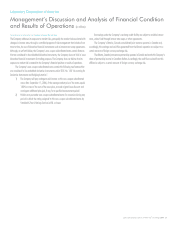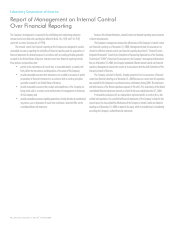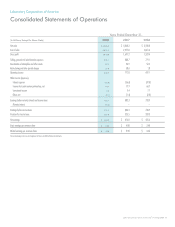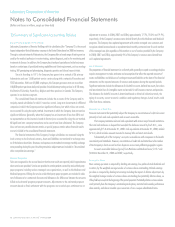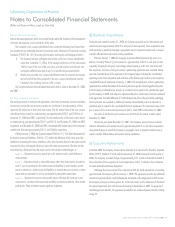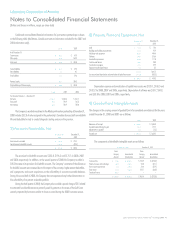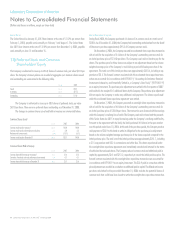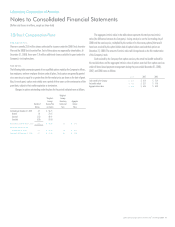LabCorp 2008 Annual Report Download - page 40
Download and view the complete annual report
Please find page 40 of the 2008 LabCorp annual report below. You can navigate through the pages in the report by either clicking on the pages listed below, or by using the keyword search tool below to find specific information within the annual report.
Notes to Consolidated Financial Statements
(Dollars and shares in millions, except per share data)
Laboratory Corporation of America
38 Laboratory Corporation of America® Holdings 2008
Short-Term Investments
At December 31, 2007, the items classified as short-term investments were principally Auction
Rate Securities (“ARS”) and Variable Rate Demand Notes (“VRDN”). The Company classified
the ARS and VRDN as available-for-sale. Securities accounted for as available-for-sale are
required to be reported at fair value with unrealized gains and losses, net of taxes, excluded
from net income and shown separately as a component of accumulated other comprehensive
income within shareholders’ equity. The securities that the Company had classified as
available-for-sale generally traded at par and as a result typically did not have any realized or
unrealized gains or losses. No gains or losses were realized on sales of ARS and VRDN for the
years ended December 31, 2008, 2007, and 2006. The Company had $0.0 and $109.9 of
ARS and VRDN classified as short-term investments as of December 31, 2008 and 2007,
respectively. All of the Company’s investments in ARS and VRDN were liquidated at cost as of
January 2, 2008.
Inventories
Inventories, consisting primarily of purchased laboratory supplies, are stated at the lower of cost
(first-in, first-out) or market.
Property, Plant and Equipment
Property, plant and equipment are recorded at cost. The cost of properties held under capital
leases is equal to the lower of the net present value of the minimum lease payments or the fair
value of the leased property at the inception of the lease. Depreciation and amortization expense
is computed on all classes of assets based on their estimated useful lives, as indicated below,
using principally the straight line method.
Years
Buildings and building improvements 35
Machinery and equipment 3-10
Furniture and fixtures 5-10
Leasehold improvements and assets held under capital leases are amortized over the shorter
of their estimated useful lives or the term of the related leases. Expenditures for repairs and
maintenance are charged to operations as incurred. Retirements, sales and other disposals of
assets are recorded by removing the cost and accumulated depreciation from the related accounts
with any resulting gain or loss reflected in the consolidated statements of operations.
Capitalized Software Costs
The Company capitalizes purchased software which is ready for service and capitalizes software
development costs incurred on significant projects starting from the time that the preliminary
project stage is completed and management commits to funding a project until the project is
substantially complete and the software is ready for its intended use. Capitalized costs include
direct material and service costs and payroll and payroll-related costs. Research and development
costs and other computer software maintenance costs related to software development are
expensed as incurred. Capitalized software costs are amortized using the straight-line method
over the estimated useful life of the underlying system, generally five years.
Long-Lived Assets
Goodwill is evaluated for impairment by applying a fair value based test on an annual basis and
more frequently if events or changes in circumstances indicate that the asset might be impaired.
Long-lived assets, other than goodwill, are reviewed for impairment whenever events or
changes in circumstances indicate that the carrying amounts may not be recoverable. Recoverability
of assets to be held and used is determined by the Company at the level for which there are
identifiable cash flows by comparison of the carrying amount of the assets to future undiscounted
net cash flows before interest expense and income taxes expected to be generated by the assets.
Impairment, if any, is measured by the amount by which the carrying amount of the assets exceeds
the fair value of the assets (based on market prices in an active market or on discounted cash
flows). Assets to be disposed of are reported at the lower of the carrying amount or fair value.
The Company completed an annual impairment analysis of its indefinite lived assets,
including goodwill, and has found no instances of impairment as of December 31, 2008.
Intangible Assets
Intangible assets (patents and technology, customer lists and non-compete agreements),
are amortized on a straight-line basis over the expected periods to be benefited, such as legal
life for patents and technology, 10 to 25 years for customer lists and contractual lives for
non-compete agreements.
Debt Issuance Costs
The costs related to the issuance of debt are capitalized and amortized to interest expense
using the effective interest method over the terms of the related debt.
Professional Liability
The Company is self-insured for professional liability claims arising in the normal course of
business, generally related to the testing and reporting of laboratory test results. The Company
records a reserve for such asserted and estimated unasserted claims based on actuarial assessments
of future settlement and legal defense costs.
Income Taxes
The Company accounts for income taxes utilizing the asset and liability method. Under this method
deferred tax assets and liabilities are recognized for the future tax consequences attributable to
differences between the financial statement carrying amounts of existing assets and liabilities and
their respective tax bases and for tax loss carryforwards. Deferred tax assets and liabilities are
measured using enacted tax rates expected to apply to taxable income in the years in which
those temporary differences are expected to be recovered or settled. The effect on deferred tax
assets and liabilities of a change in tax rates is recognized in income in the period that includes
the enactment date. The Company does not recognize a tax benefit, unless the Company concludes
that it is more likely than not that the benefit will be sustained on audit by the taxing authority
based solely on the technical merits of the associated tax position. If the recognition threshold
is met, the Company recognizes a tax benefit measured at the largest amount of the tax benefit
that the Company believes is greater than 50 percent likely to be realized. The Company records
interest and penalties in income tax expense.



